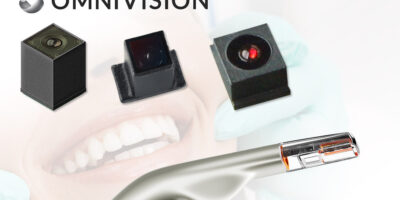Omnivision partners with Biotech Dental to develop accurate 3D intraoral scanners
Omnivision, has announced a partnership that involves Biotech Dental’s use of multiple medical-grade camera modules from Omnivision in the design of its new Scan4All 3D intraoral scanners Iris by Starck. The camera modules for dental applications feature Omnivision’s CameraCubeChip technology with an integrated lens.
The Scan4All intraoral scanner Iris by Starck is a handheld device that is slightly larger than the size of an electric toothbrush; it uses sophisticated software to develop a 3D digital model of a patient’s teeth and gums, which can then be used to create dental restorations and implants. This method is significantly more convenient and accurate compared to the traditional dental putty approach. However, most intraoral scanners available today have only one image sensor, inhibiting their speed and accuracy. Biotech Dental is addressing this pain point by partnering with Omnivision to develop intraoral scanners with multiple image sensors that produce quick and accurate high-quality 3D dental models.
“We partnered with Omnivision due to the wide range of imaging solutions they offer for dental applications. Most importantly, Omnivision’s camera modules are developed and tested specifically for the medical and dental markets and have a long lifetime, which in turn, ensures that our intraoral scanners retain their value and remain a high-quality solution for our customers,” said Philippe VERAN, CEO, Biotech Dental.
According to Ehsan Ayar, medical product marketing manager, Omnivision, “Biotech Dental offers innovative, high-quality solutions for the dental industry. We are excited to partner with them to enhance their next-generation intraoral scanners, which will use several of our medical-grade high-resolution image sensors, taking dental visualization to the next level. We are the only company that offers a wide range of medical-grade imagers, which go through extensive biocompatibility, sterilization and medical tests. This gives dental professionals peace of mind during procedures.”
3D intraoral scanners are quickly replacing the use of traditional dental putty impressions, which are time consuming, complex and can be inaccurate. Data Bridge Market Research expects the global dental intraoral scanners market to grow with a compound annual growth rate (CAGR) of 11.1% from 2023 to 2030 and is expected to reach USD 1,325.80 million by 2030 from USD 573.76 million in 2022. 1
Both the OCH2B30 and OCHSA10 utilise Omnivision’s PureCelPlus-S stacked-die technology, which enables their compact size. The OVM9724 is built on Omnivision’s powerful OmniBSI+ pixel architecture to enable high-quality colour images and fast-frame video. CameraCubeChip is a reflowable, all-in-one camera drop-in solution—there is no need for additional optical components, which significantly streamlines manufacturing. The combination of excellent image quality and small form factor make the camera modules ideal for integration into slim, compact devices, such as the tip of the 3D intraoral scanner.
Omnivision is ISO13485-certified; the camera modules are tested for electromagnetic interference (EMC) and electromagnetic compatibility (EMI) compliance and sterilisation. They are also biocompatible and waterproof. www.ovt.com/contact-sales.




